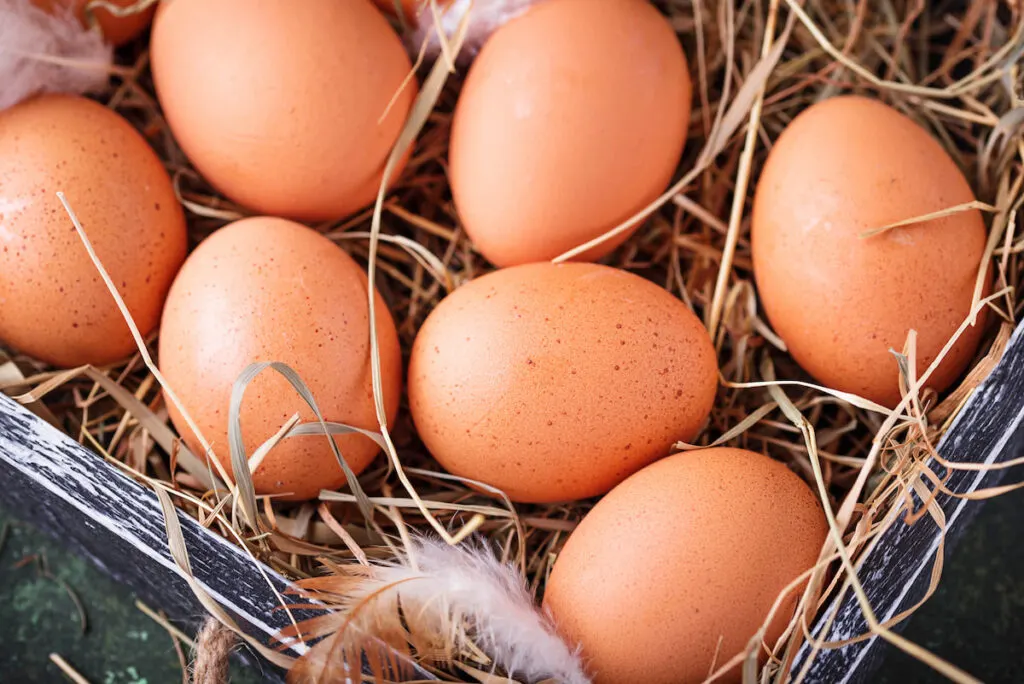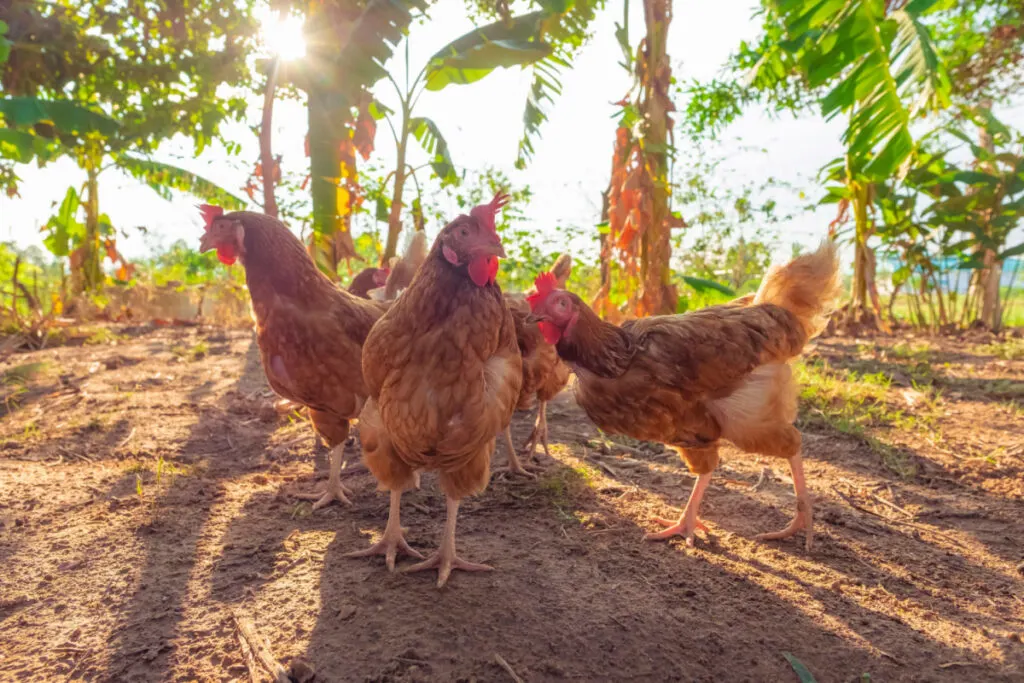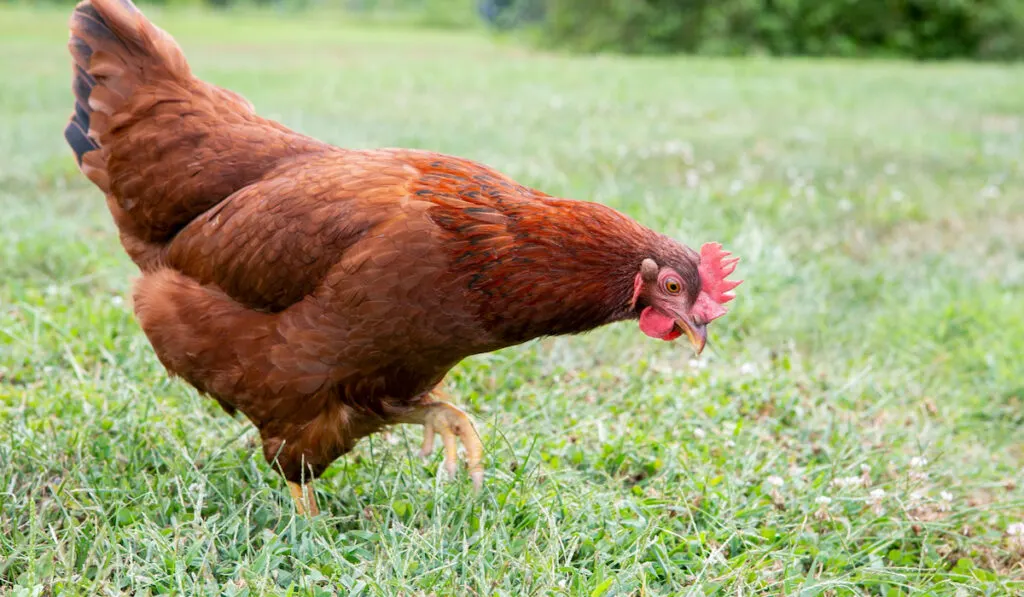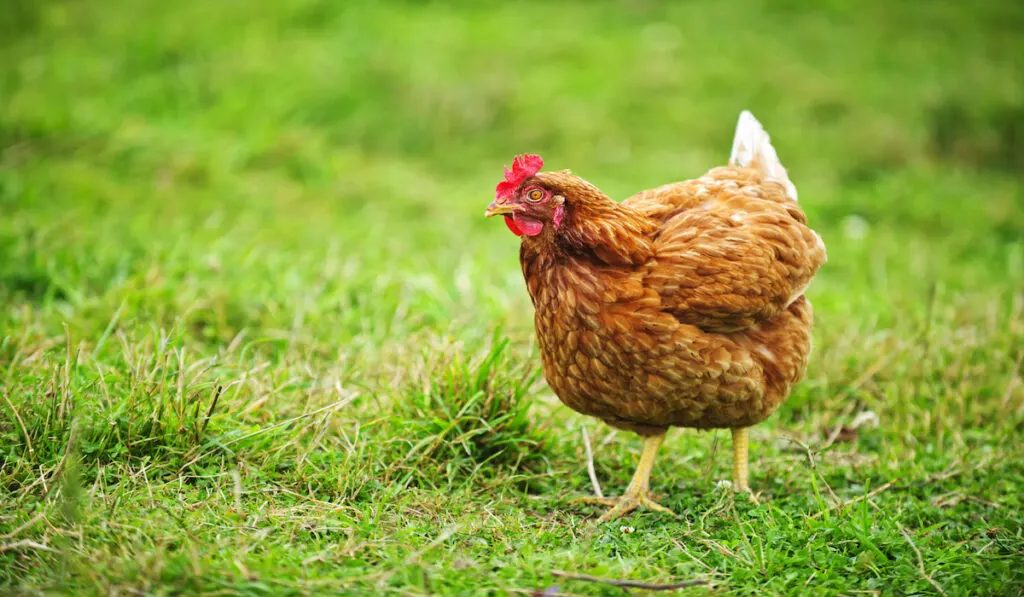The Rhode Island Red is one of the most accomplished chicken breeds. It is a popular low-maintenance chicken breed developed in Massachusetts and Rhode Island.
The Rhode Island Red was developed by crossing Malay, Brown Leghorns, Java, Plymouth Rocks, Chinese Cochin, and Light Brahmas.
Rhode Island Reds were developed as dual-purpose birds but can be kept as pets due to their friendly nature.
They also make good show birds and are also well known for their egg-laying abilities and hardiness.
There are two strains of the Rhode Island Red: the heritage strain and the production strain. The production strain generally offers more eggs than the heritage strain.
But while the heritage strain may not lay as many eggs, it keeps producing for an extended period.
Away from the details provided above, we discuss 15 other fun facts about the Rhode Island Reds in the rest of this article.
Table of Contents
When Do Rhode Island Reds Start Laying?
A Rhode Island Red hen usually starts laying eggs at around 18-24 weeks old. However, some hens will begin laying as early as 16 weeks old.
Due to their exceptional egg-laying abilities, the output and continuity of a Rhode Island Red hen are often difficult to surpass.
You Can Get Up to 300 Eggs From One Layer in a Year!
The egg production of Rhode Island Reds depends on the strain you own. A production strain hen can lay around 200-300 eggs each year. And this equals a laying rate of 5-6 eggs every week.
Heritage strains of the Rhode Island Red lay around 150-200 eggs each year. This puts the weekly egg-laying figure at 3-4 eggs.

The Eggs Become Larger as the Layers Become Older
Rhode Island Red hens lay medium to large-sized light brown colored eggs. However, the size of the eggs will increase as they get older.
They Have Red Plumage That Can Become Lighter With Time
Rhode Island Reds have a beautiful deep red to almost black plumage. However, the red color of the breed tends to fade over time due to regular sunlight exposure. They can sometimes have black feathers on their wings and tails.
Rhode Island Red chicks have a soft rust color with two dark lines on their backs. As they mature, their feathers start having patterns of rust and black. However, these patterns fade once they are fully mature.
Other Body Features of the Rhode Island Reds
The Rhode Island Red is a breed with superior exhibition qualities.
They have rectangular bodies that are relatively long, solid, and well-proportioned. They have tight and compact feathers, which is a trait inherited from the Malay breed. Their tails are positioned at a 45-degree angle.
Rhode Island Reds have red ear lobes, wattles, and combs, with red or orange eyes. They also have yellow skins, legs, and feet. Their beaks are horn or yellowish.
Rhode Island Reds can either have a single or a rose comb, usually in vivid red.
They Are Medium-Sized Birds
Rhode Island Reds are medium-sized birds. On average, hens can weigh around 6.5 pounds, while roosters weigh 8.5 pounds.
For the bantam variety, roosters weigh an average of 2.1 pounds, while hens weigh 1.9 pounds. Bantam breeds are miniature versions created from the original breed.

Rhode Island Reds Can Be a Bit Assertive
Rhode Island Reds are well known for being a bit aggressive and surprisingly territorial, especially among roosters. Their temperament can go from docile to unpleasant and sometimes pushy.
Although Rhode Island Red Hens are not known for being hostile, they do tend to be ornery.
Although Rhode Island Reds tend to be cranky, they are pretty energetic and fun to watch. Still, if you have children or other pets, this chicken breed is not ideal for you.
They Are Best Raised Alone or Amongst Other Assertive Chicken Breeds
If you intend to raise only Rhode Island Reds, their aggressive inclinations will not be a problem. But if you have other chicken breeds in your backyard flock, there may be issues.
To avoid such issues, ensure you only keep the Rhode Island Reds with equally aggressive breeds. Housing them with other assertive chickens will ensure that they are not unduly dominant.
They Are Not Always Broody
Rhode Island Red Hens are not known to go broody. Although this instinct has been suppressed by selection and breeding, they tend to go broody on occasion.
When hens become broody, they will sit on eggs, and they become protective mothers.
Rhode Island Reds Are Curious Birds
Rhode Island Reds are also well known for their curiosity and tend to end up in situations they shouldn’t. If you plan on raising Rhode Island Reds, ensure you have enough space for them to forage.

They Are Pretty Hardy
Rhode Island Reds are hardy birds with few health issues. They can thrive in almost any condition, and they rarely fall ill.
However, as with all birds, mites and other ectoparasites can become a problem. You can prevent this through careful examination, dust baths, and anti-parasite dusting.
You can also improve the overall health of your chickens by preventing overcrowding and maintaining a clean coop.
In all respects, the Rhode Island Red is a healthy and active chicken breed.
Rhode Island Reds Are Predator Savvy
Rhode Island Reds are predator-savvy birds with a good awareness of other animals in their vicinity while they forage. This is one of the many reasons they excel in free-range environments.
The only issue with allowing them free-range is that you have to search for all those eggs. A Rhode Island Red hen will always find a suitable place to lay her eggs, and most times, it will not be in your nesting box.
Noise Levels
Rhode Island Reds can be a bit rowdy and noisy. Although they are not always loud, they tend to be quite talkative and are always happy when interacting with humans.
If you reside in a quiet area or have quiet neighbors, these birds are not ideal for you.
They Are Highly Adaptable
You can raise a Rhode Island Red almost anywhere in the country. These birds are highly adaptable and will thrive in a coop or as free-range birds. However, the Rhode Island Red chicken breed thrives more in colder climates.
Although these birds can become vulnerable to frostbite, you can easily prevent such by applying some petroleum jelly to their comb.
In southern climates, it is a bit difficult to prevent these birds from suffering heat exhaustion.

Rhode Island Reds Can Survive With Minimal Care
The care Rhode Island Reds require is not so different from the care given to any other breed. These birds are low maintenance, especially when it comes to feeding since they are excellent foragers.
For chicks, all they require for the first few weeks is a high-quality chick starter. Once the chicks are 16 weeks old, they can transition to a laying feed.
When it comes to housing, Rhode Island Reds do not like being crowded. You must provide adequate housing. Within the coop, there should be 4 square feet of space per chicken. And outside, at least 10 square feet.
This chicken breed is hardy and designed to tolerate extreme winter conditions. As a result, their coop requires minimal weatherproofing.
On Average, They Live For More Than 5 Years
The Rhode Island Reds are self-sufficient, and this plays a massive role in how long they live.
On average, Rhode Island Reds can live for 5-8 years, and if they are cared for properly, they can easily outlive this. To ensure they live long and healthy lives, Rhode Island Reds require regular vaccinations and worming.
Resources:
- https://www.thehappychickencoop.com/rhode-island-red/
- https://www.chickensandmore.com/rhode-island-red/
- https://informativefacts.com/rhode-island-red-facts/
- https://www.roysfarm.com/rhode-island-red-chicken/
- https://www.knowyourchickens.com/rhode-island-red-chicken/
- https://www.chickensandmore.com/how-long-do-chickens-live/
- https://www.burkesbackyard.com.au/fact-sheets/pets/pet-road-tests/birds/rhode-island-reds/
- https://www.mannapro.com/homestead/bid/145273/chicken-breeds-spotlight-rhode-island-reds
